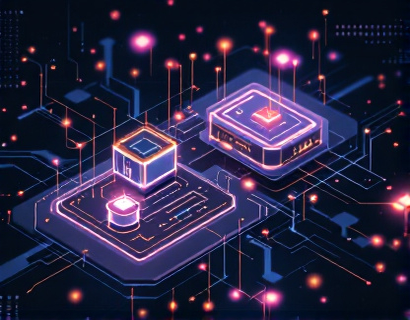Mastering Digital Currency Creation: A Comprehensive Guide to Next-Gen Software for Businesses and Blockchain Innovators
In the rapidly evolving landscape of blockchain technology, the ability to create and manage digital currencies has become an essential skill for businesses and innovators. This comprehensive guide aims to demystify the complex process of launching and managing digital tokens and currencies, providing a roadmap for both beginners and experts to navigate the blockchain space with confidence. By leveraging advanced software tools, businesses can streamline their development efforts and ensure their digital currencies are secure, customizable, and scalable.
Understanding Digital Currency Creation
Digital currencies, often referred to as cryptocurrencies, operate on blockchain technology, a decentralized ledger that records transactions across multiple computers. The creation of a digital currency involves several key steps, including defining the currency's purpose, designing the blockchain architecture, implementing smart contracts, and ensuring robust security measures. Advanced software tools are crucial in simplifying these steps, making it accessible for a wider range of users.
Key Features of Advanced Digital Currency Software
Modern software for digital currency creation offers a suite of features designed to enhance customization, security, and scalability. These tools enable developers to tailor their currencies to specific use cases, ensuring that each token meets the unique needs of its target market. Here are some of the key features to look for in advanced digital currency software:
- Customizable Blockchain Parameters: Advanced software allows developers to adjust parameters such as block size, difficulty, and consensus mechanisms to optimize performance and security.
- Robust Security Protocols: Security is paramount in digital currency creation. Advanced tools incorporate best practices such as multi-signature wallets, cold storage options, and regular security audits to protect against potential threats.
- Scalability Solutions: As user adoption grows, the ability to scale is crucial. Advanced software supports various scalability solutions, including sharding, sidechains, and layer 2 protocols, to handle increasing transaction volumes efficiently.
- User-Friendly Interfaces: For non-technical users, intuitive interfaces and drag-and-drop tools make it easier to design and deploy digital currencies without extensive coding knowledge.
- Comprehensive Documentation and Support: Detailed guides, tutorials, and responsive support teams ensure that users can overcome challenges and fully leverage the software's capabilities.
Streamlining the Development Process
The development of a digital currency can be a complex and time-consuming process. Advanced software streamlines this process by providing pre-built templates, automated testing frameworks, and continuous integration tools. These features enable developers to focus on innovation rather than reinventing the wheel. Here’s how advanced software can simplify each stage of the development process:
1. Design Phase
During the design phase, developers can use the software to define the currency's specifications, including token economics, smart contract functionality, and network architecture. Pre-built templates and design tools allow for quick prototyping and iteration, ensuring that the currency aligns with the desired goals.
2. Development Phase
Once the design is finalized, the development phase begins. Advanced software provides a robust development environment with integrated development tools, code editors, and version control systems. These tools facilitate collaborative development, code review, and debugging, accelerating the development timeline.
3. Testing Phase
Testing is a critical step to ensure the digital currency functions correctly and securely. Advanced software includes automated testing frameworks that simulate various scenarios, identify bugs, and ensure compliance with security standards. This phase also involves regular security audits to identify and mitigate potential vulnerabilities.
4. Deployment Phase
Deployment involves launching the digital currency on the blockchain network. Advanced software simplifies this process by providing tools for deploying smart contracts, configuring node networks, and managing wallet integrations. Automated deployment scripts and rollback mechanisms ensure a smooth and error-free launch.
Ensuring Security and Compliance
Security and compliance are non-negotiable aspects of digital currency creation. Advanced software incorporates several measures to address these concerns:
Security Measures
1. Multi-Signature Wallets: Requires multiple approvals for transactions, reducing the risk of unauthorized access.
2. Cold Storage: Storing private keys offline minimizes the risk of hacking and theft.
3. Regular Security Audits: Third-party audits identify and address vulnerabilities, ensuring the currency remains secure over time.
Compliance Considerations
Digital currencies must comply with local and international regulations. Advanced software helps developers navigate these requirements by:
- Providing templates for Know Your Customer (KYC) and Anti-Money Laundering (AML) compliance.
- Offering guidance on reporting requirements and regulatory filings.
- Integrating with compliance management tools to stay updated on regulatory changes.
Scalability and Performance Optimization
As the user base grows, the digital currency must scale to handle increased transaction volumes without compromising performance. Advanced software offers several solutions to ensure scalability and performance:
Scalability Solutions
1. Sharding: Divides the blockchain into smaller, manageable parts (shards) to process transactions in parallel, increasing throughput.
2. Sidechains: Allows for off-chain transactions, reducing the load on the main chain and improving efficiency.
3. Layer 2 Protocols: Solutions like state channels and plasma enable faster and cheaper transactions by processing them off the main blockchain.
Performance Optimization
To maintain a smooth user experience, performance optimization is essential. Advanced software includes tools for:
- Optimizing smart contract code to reduce gas costs and improve execution speed.
- Implementing caching mechanisms to reduce database load and improve response times.
- Monitoring network performance and automatically scaling resources to handle peak loads.
Case Studies and Real-World Applications
To better understand the practical applications of advanced digital currency software, let’s explore a few case studies:
Case Study 1: Decentralized Finance (DeFi) Platform
A DeFi platform used advanced software to create a custom token for lending and borrowing services. The software’s customizable blockchain parameters allowed the team to optimize for low latency and high transaction throughput, essential for real-time trading. The robust security features, including multi-signature wallets and regular audits, ensured the platform’s funds were safe from theft and fraud.
Case Study 2: Supply Chain Management
A supply chain company implemented a digital currency to facilitate seamless transactions between suppliers and retailers. The software’s scalability solutions, such as sharding and sidechains, enabled the platform to handle millions of transactions daily without performance degradation. The user-friendly interface allowed non-technical users to easily integrate the currency into their existing systems.
Future Trends in Digital Currency Creation
The landscape of digital currency creation is continually evolving, driven by advancements in blockchain technology and increasing adoption. Here are some future trends to watch:
1. Interoperability
As more blockchains emerge, the ability for different networks to communicate and transfer assets seamlessly becomes crucial. Advanced software will increasingly support cross-chain interoperability, allowing digital currencies to operate across multiple platforms.
2. Central Bank Digital Currencies (CBDCs)
Central banks around the world are exploring CBDCs to leverage the benefits of blockchain technology while maintaining control. Software tools will adapt to support the creation and management of CBDCs, ensuring they meet regulatory and security standards.
3. User-Centric Design
As the digital currency market grows, user experience will become a key differentiator. Advanced software will focus on developing intuitive interfaces and educational resources to make blockchain technology accessible to a broader audience.
Conclusion
Mastering digital currency creation is no longer the domain of tech experts alone. With advanced software tools, businesses and innovators can confidently enter the blockchain space, creating custom, secure, and scalable digital currencies. By leveraging these tools, users can streamline their development process, ensure robust security, and prepare for future growth. As the landscape continues to evolve, staying informed and adaptable will be key to success in the world of digital currencies.










































